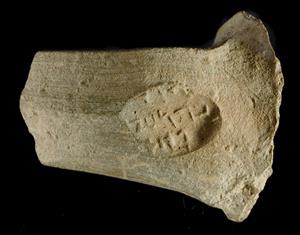Yehud stamps are administrative impressions on jar handles that were prevalent in the Persian province of Yehud and the early Hellenistic toparchy (district) of Judah. The first handle with this stamp was discovered during British archaeologist Frederick Bliss’s excavations in Jerusalem from 1894 to 1897 and published a year later. However, it was not deciphered at that time. Subsequently, additional handles were found, and it was initially suggested that they bore the inscription ‘YHW,’ referring to the name of God. It was not until 1934 that Israeli archaeologist Eliezer Sukenik deciphered the word ‘Yehud.’
Today, 17 different types of Yehud stamps are known, including handles that also bear the name of the settlement ‘Mozah,’ and handles that include the names of administrative figures in the province, such as ‘Ahiv,’ ‘Hanana,’ and ‘Uriyo.’ These types are divided into three groups: the early group, dated to the late 6th or early 5th century BCE to the 4th century BCE; the intermediate group, dated to the 3rd-4th centuries BCE; and the late group, dated to the 2nd century BCE.


Persian period jar handle found at Ramat Rahel, with the words “yhwd yhw’zr phw” (Translation: ‘Yehud, Yeho’ezer, the governor’) impressed on it. (Source: Israel Antiquities Authority).
Source:
O. Lipschits and D. S. Vanderhooft, ‘Jerusalem in the Persian and Hellenistic Periods in Light of the “Yehud” Stamp Impressions’, Eretz-Israel 28 (2007), pp. 106-115.
F. J. Bliss and A. H. Dickie, Excavations at Jerusalem, 1894-1897, London 1898.
E. L. Sukenik, ‘Paralipomena Palæstinensia’, JPOS 14 (1934), pp. 178-184, pls. I-III.

